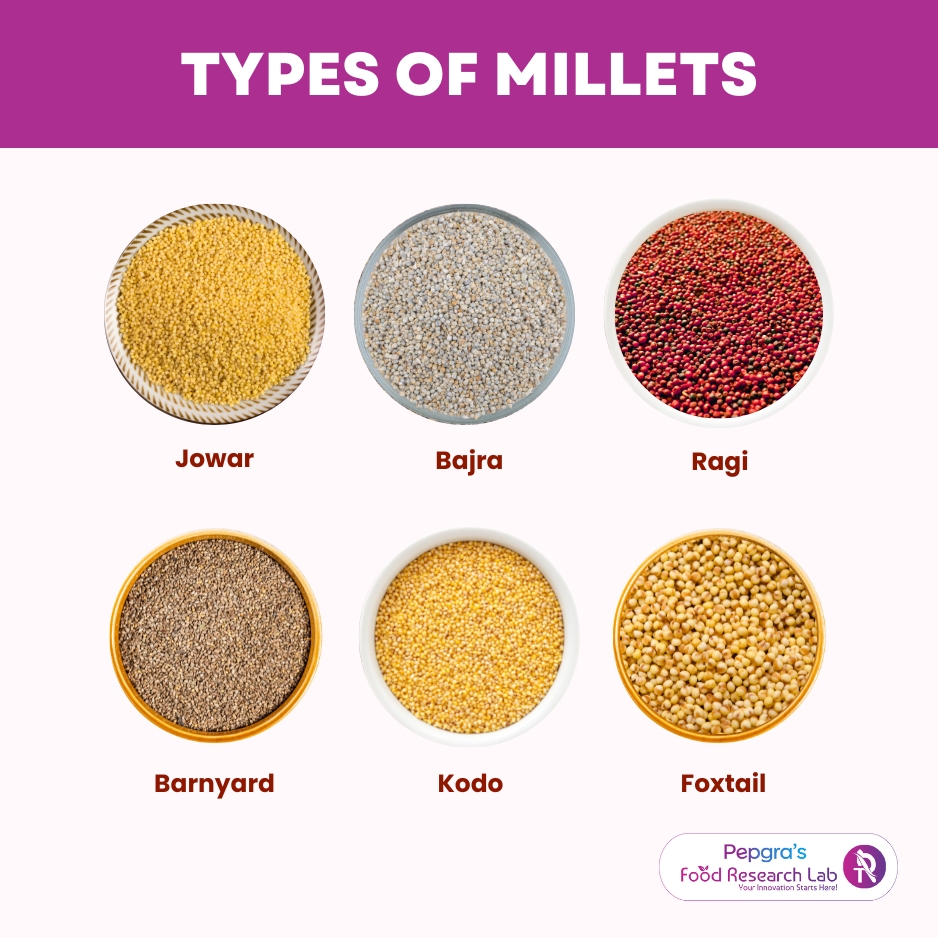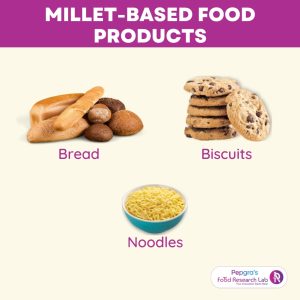
Leveraging Millets for Food Innovations
Introduction
Millets were among the first crops cultivated as a food source, documented in 3000 BC, during the Indus Valley civilization [1]. According to the Food and Agriculture Organization (FAO), ‘millets‘ is a collective term referring to small-seeded grain–containing grasses that thrive on marginal soils in tropical, subtropical and temperate climates [2]. Millets can be broadly classified as major millets; consisting of Sorghum (jowar) and pearl millet (bajra), and minor millets; which include finger millet(ragi) and small millets (Barnyard, Kodo, Foxtail, Little, Proso) [3].
 Fig 1: Types of Millets
Fig 1: Types of Millets
Millets as a ‘Smart food‘
- The International Crops Research Institute for the Semi-Arid Tropics (ICRISAT) enlists three criteria for smart food: ‘Good for you‘, ‘Good for the planet‘ and ‘Good for Farmer‘, and millets seem to fulfil these requirements. Millets have a lower carbon footprint, which benefits the planet; they require lower inputs for growth and can survive under harsh conditions, reducing losses for the farmer. They are nutrient-dense, implying that it is good for the consumer’s health [3]. They are abundant in iron, calcium, phosphorous and vitamins like thiamine (vitamin B1), riboflavin (vitamin B2) and niacin (vitamin B3). They contain resistant starches required for short-chain fatty acid production in the colon, preventing colon cancer. They also contain antioxidants, which help prevent and manage obesity, age-related health issues and chronic diseases [4].
- The millet consumption had decreased over the past years, for consumers preferred finer cereals like rice and wheat. However, millets have returned as a food source due to the rising cases of non-communicable diseases like diabetes and hypertension, for they have a low Glycaemic Index (GI), making them diabetic-friendly. In addition, they are gluten-free, suitable for gluten sensitive individuals [5].
Role of food industries:
- A study done by ICRISAT on millets revealed that 22 per cent of the respondents in the urban areas did not like the taste of millets and hence, did not consume them. The food industry can identify this gap and formulate wholesome and delicious products, using millets as an ingredient that can be delivered in ready-to-eat and ready-to-cook forms. Products that are ready-to-eat can be eaten as soon as the package is opened. Baked goods like bread and biscuits, snacks like popcorn and extruded snacks, and instant food like flakes are a few examples of these products.
- Ready-to-cook forms are those that require hot milk or hot water for preparation. Hot cereals that require hot milk or hot water for preparation. Ready-to-cook forms also include those which can be cooked with boiling water. For example, instant foods like noodles, vermicelli, and pasta and mixes for preparing upma, idli, and dosa. Weaning food and beverages with all the essential nutrients for kids to support their growth could also be developed by food and beverage manufacturers [3].

Fig 2: Millet-based food products
Innovations in product development using millet as a raw ingredient
i) Innovative bakery products
Studies have shown that millet flour can replace wheat flour by up to 40% for preparing bakery products. Products like chocolate cake, soup sticks, masala cake and gel cake had a great taste, appearance, texture and overall acceptability score when finger millet was used as an ingredient. Malted finger millet was used to improve the nutritional profile of the cake [6].
ii) Development of a high-calorie biscuit
Pearl millet was used as a raw ingredient for developing a high-calorie biscuit that serves as a nutrient-rich food for athletes and victims of natural disasters [7].
iii) Preparation of products from millet flakes
Food manufacturers are increasingly incorporating millet for their products. For instance, millet flakes, that are prepared after soaking, roasting, and then passing the millets through a drying machine. They could be used to prepare many products, such as savoury (by seasoning with spices), muesli (by coating thick flakes with honey and seasoning them with dry fruits, jaggery or fruit sugar), chocolate flakes (by coating the flakes with molten chocolate) and Nutri-bars (by blending different types of millets with dry fruits, pulverizing them and mixing with sugar syrup, drying and cutting them in desired shape) [6].
Conclusion
Millets are one of the oldest crops produced for food. They are rich in nutrients and can act as an adjuvant in following a healthy lifestyle. Innovative products incorporating millet, like ready-to-eat and ready-to-cook millet products have been developed to meet the consumers‘ demand for healthy products.
How the Food Research Lab can help
The Food Research Lab has a team of experts specializing in ingredient development, food product development or reformulating an existing product. It bridges knowledge and creativity and is open to innovation while formulating products. The products are developed after a series of tests so that they are delectable and wholesome.





